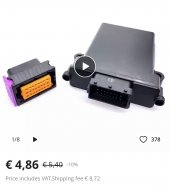Goboatingnow
Solar Enthusiast
- Joined
- Jul 3, 2022
- Messages
- 1,325
View attachment 114943
Hope this block diagram is visible note it’s not electrically perfect
This bms is based on a battery by battery basis in this case each battery is 4 series cells resulting in a nominal 12v 100Ah battery
The bms has a high side mosfet disconnect and uses an ATTINY connected to a dedicated analog front end. ( there are several haven’t finalised one yet. ) these chips handle the large common mode voltage of the series series
Some things are omitted. The current is sensed using the Vds drop across the mosfets ( bidirectional mosfet switch. ) however I could equally use a simply sense shunt as some front ends have a shunt reading ability.
The mosfets are high side so the system ground remains intact so comms can continue even post mosfet disconnect
A haltek switched capacitor active balancer is present running under the ATTINY control. This prevents balancing until the upper knee voltage is approaching.
Each cell has voltage sensing to 1mV accuracy and temperature measurement per cell.
A wired OR fault and alarm lines run between each BMS per battery. Alarm is a pre warning of impending disconnect and fault Indicates disconnect.
As can be seen each battery unit is connected to a ESP32-C3 ( RISC V) based communications monitoring unit. This communicate to the bms modules via LIN bus which is a simple serial system. The esp polls each bms and equally monitors the fault and Alarm lines.
The comms module has CAN WIFI and Bluetooth supporting potential connections to Victron VE.CAN or Bluetooth setup apps. It’s intended that charge and load commands would be issued over CAN. But equally dedicated IO lines could be provided if needs be to allow selective load disconnect strategies or charge start stop.
I’m working on this project post Christmas as I’m currently designing a new alternator controller
Hope this block diagram is visible note it’s not electrically perfect
This bms is based on a battery by battery basis in this case each battery is 4 series cells resulting in a nominal 12v 100Ah battery
The bms has a high side mosfet disconnect and uses an ATTINY connected to a dedicated analog front end. ( there are several haven’t finalised one yet. ) these chips handle the large common mode voltage of the series series
Some things are omitted. The current is sensed using the Vds drop across the mosfets ( bidirectional mosfet switch. ) however I could equally use a simply sense shunt as some front ends have a shunt reading ability.
The mosfets are high side so the system ground remains intact so comms can continue even post mosfet disconnect
A haltek switched capacitor active balancer is present running under the ATTINY control. This prevents balancing until the upper knee voltage is approaching.
Each cell has voltage sensing to 1mV accuracy and temperature measurement per cell.
A wired OR fault and alarm lines run between each BMS per battery. Alarm is a pre warning of impending disconnect and fault Indicates disconnect.
As can be seen each battery unit is connected to a ESP32-C3 ( RISC V) based communications monitoring unit. This communicate to the bms modules via LIN bus which is a simple serial system. The esp polls each bms and equally monitors the fault and Alarm lines.
The comms module has CAN WIFI and Bluetooth supporting potential connections to Victron VE.CAN or Bluetooth setup apps. It’s intended that charge and load commands would be issued over CAN. But equally dedicated IO lines could be provided if needs be to allow selective load disconnect strategies or charge start stop.
I’m working on this project post Christmas as I’m currently designing a new alternator controller



